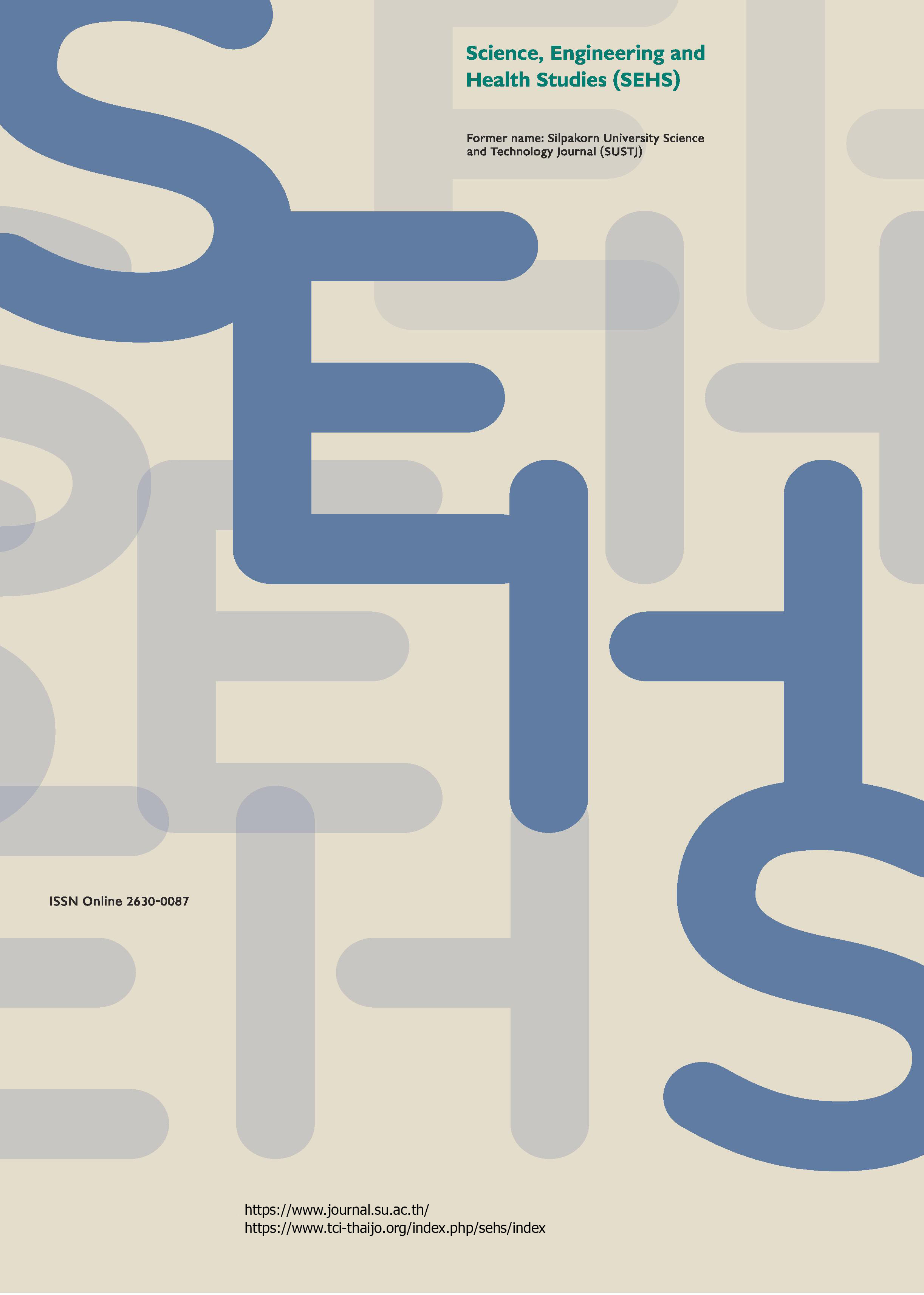Antibacterial activity of Mitragyna speciosa Korth. leaves
Main Article Content
Abstract
The crude extracts of red vein kratom leaves (hexane, dichloromethane, ethyl acetate, ethanol, and 50% acetic acid) and mitragynine were tested for antibacterial activity against gram-positive Staphylococcus aureus and gram-negative Escherichia coli using the disk diffusion method. The minimum inhibitory concentration (MIC) values against S. aureus and E. coli were determined. The acetic acid crude extract was effective against both S. aureus and E. coli with an inhibition zone of 5.52±0.44 and 4.65±1.02 mm, at a minimum concentration of 6 and 9 mg/mL, respectively. Mitragynine was active against S. aureus with an inhibition zone of 4.35±0.68 mm and a MIC of 6 mg/mL.
Downloads
Article Details

This work is licensed under a Creative Commons Attribution-NonCommercial-NoDerivatives 4.0 International License.
References
Arruda, M. O., Mendes, S. J. F., Teixeira, S. A., de Mesquita, L. S. S., de Sousa Ribeiro, M. N., de Sousa Lima Galvão, S., Muscará, M. N., Fernandes, E. S., and Monteiro-Neto, V. (2017). The hydroalcoholic extract obtained from Mentha piperita L. leaves attenuates oxidative stress and improves survival in lipopolysaccharide-treated macrophages. Journal of Immunology Research, 2017, 2078794.
Bai, J., Li, J., Chen, Z., Bai, X., Yang, Z., Wang, Z., and Yang, Y. (2023). Antibacterial activity and mechanism of clove essential oil against foodborne pathogens. Lebensmittel-Wissenschaft & Technologie, 173, 114249.
Clinical and Laboratory Standards Institute (CLSI). (2009). Methods for Dilution Antimicrobial Susceptibility Test for Bacteria That Grow Aerobically, 11th, Wayne, PA: Clinical and Laboratory Standards Institute, pp. 15–52.
Cowan, M. M. (1999). Plant products as antimicrobial agents. Clinical Microbiology Reviews, 12(4), 564–582.
Flores-Bocanegra, L., Raja, H. A., Graf, T. N., Augustinović, M., Wallace, E. D., Hematian, S., Kellogg, J. J., Todd, D. A., Cech, N. B., and Oberlies, N. H. (2020). The chemistry of kratom [Mitragyna speciosa]: Updated characterization data and methods to elucidate indole and oxindole alkaloids. Journal of Natural Products, 83(7), 2165–2177.
Gordon, R. J., and Lowy, F. D. (2008). Pathogenesis of methicillin-resistant Staphylococcus aureus infection. Clinical Infectious Diseases, 46(Suppl 5), S350–S359.
Grewal, K. S. (1932a). Observations on the pharmacology of mitragynine. Journal of Pharmacology and Experimental Therapeutics, 46(3), 251–271.
Grewal, K. S. (1932b). The effect of mitragynine on man. British Journal of Medical Psychology, 12(1), 41–58.
Harizal, S. N., Mansor, S. M., Hasnan, J., Tharakan, J. K. J., and Abdullah, J. (2010). Acute toxicity study of the standardized methanolic extract of Mitragyna speciosa Korth in rodent. Journal of Ethnopharmacology, 131(2), 404–409.
Kosalec, I., Jembrek, M. J., and Vlainić, J. (2022). The spectrum of berberine antibacterial and antifungal activities. In Promising Antimicrobials from Natural Products (Rai, M. and Kosalec, I., Eds.), pp.119–132. Cham: Springer.
León, F., Habib, E., Adkins, J. E., Furr, E. B., McCurdy, C. R., and Cutler, S. J. (2009). Phytochemical characterization of the leaves of Mitragyna speciosa grown in USA. Natural Product Communications, 4(7), 907–910.
Machado, T. B., Leal, I. C. R., Amaral, A. C. F., dos Santos, K. R. N., da Silvac, M. G., and Kuster, R. M. (2002). Antimicrobial ellagitannin of Punica granatum fruits. Journal of the Brazilian Chemical Society, 13(5), 606–610.
McGann, P., Snesrud, E., Maybank, R., Corey, B., Ong, A. C., Clifford, R., Hinkle, M., Whitman, T., Lesho, E., and Schaecher, K. E. (2016). Escherichia coli harboring mcr-1 and blaCTX-M on a novel IncF plasmid: First report of mcr-1 in the United States. Antimicrobial Agents and Chemotherapy, 60(7), 4420–4421.
Muandao, K., Shooskoonkriang, S., and Niyomdecha, M. (2018). Comparative extraction method of mitragynine for forensic science. In National Conference in Science and Technology, Bansomdejchaopraya Rajabhat University, Bangkok, Thailand. July 19–20.
Nakaphan, T., Teerachaisakul, M., Puttum, S., Sompimai, K., and Nootim, P. (2016). Traditional use of kratom (Mitragyna speciosa Korth) among folk healers in Southern Thailand. Journal of Thai Traditional and Alternative Medicine, 14(3), 274–285. [in Thai]
Narcotics Act B.E. 2522. (1979, April 27). Royal Thai Government Gazette (Vol. 96, Part 63, Special Issue, p. 44). [Online URL: https://www.ocs.go.th/council-of-state/#/public/doc/U2FaUEN2MTBBc3ZYWm42UkhQM0Uxdz09] accessed on July 10, 2022.
Parthasarathy, S., Bin Azizi, J., Ramanathan, S., Ismail, S., Sasidharan, S., Said, M. I. M., and Mansor, S. M. (2009). Evaluation of antioxidant and antibacterial activities of aqueous, methanolic and alkaloid extracts from Mitragyna speciosa (Rubiaceae family) leaves. Molecules, 14(10), 3964–3974.
Salim, H. M., Puspitarini, M. D., Setiwati, Y., and Shimabukuro, M. (2021). Antibacterial mechanism of kratom (Mitragyna speciosa) methanol extract on Streptococcus pneumoniae and Eschericia coli bacteria. Biomolecular and Health Science Journal, 4(2), 99–103.
Suwanlert, S. (1975). A study of kratom eaters in Thailand. Bulletin on Narcotics, 27(3), 21–27.
Weese, J. S. (2010). Methicillin-resistant Staphylococcus aureus in animals. Institute for Laboratory Animal Research Journal, 51(3), 233–244.
Ventola, C. L. (2015). The antibiotic resistance crisis: part 1: Causes and threats. Pharmacy and Therapeutics, 40(4), 277–283.


